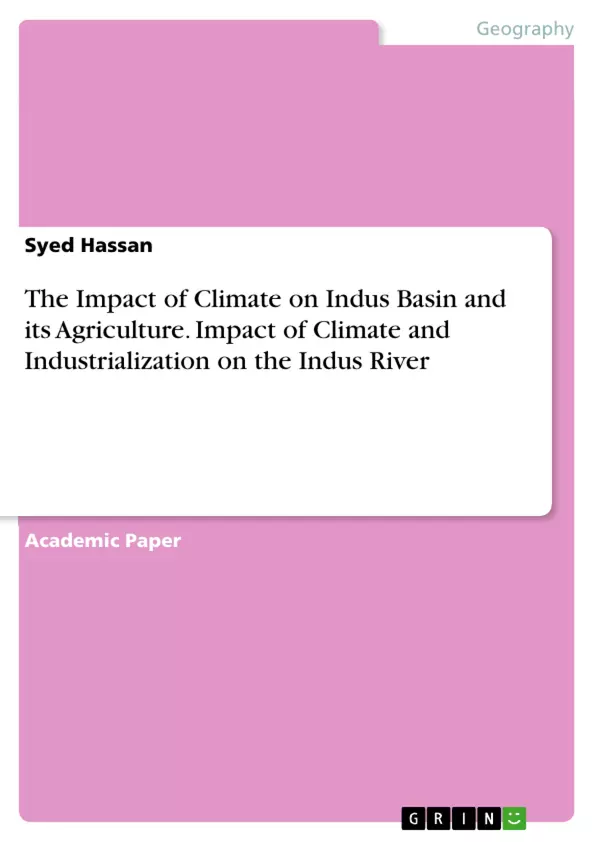This study came at a critical time in the area. The feeble seasonal monsoon of 2009 caused a deficiency across the Pakistan. This comes after many rural households were already in dire straits facing high fertilizer charges and the impact of increasing world food prices. To aggravate the matters, the calamitous monsoon floods of 2010 overblown more than 22 million people, their homelands, structure and harvests. It has been estimated that this single flood caused around US$10 billion in damage, about partial of which was due to fatalities in the agricultural division.
Introduction: The Indus Basin has a long and lively history of growth and alteration in irrigation. The settlements of the Harappan evolution in the Indus Valley date back five millennia. During the monsoon season, traces of flood channels remain that cut through the floodplains and allowed the inundation of agricultural fuel, food and minor crops within the riparian corridor. One of the largest dams, the so-called Gabarbands, dam water in torrents and branch catchment areas. Urban toilets and manure systems which aided cities such as Mohenjo-Daro in the Pakistan, Sindh’s lower Indus River section. such smaller cities and were discovered in the 2nd millennium BC. Abandoned due to overflowing of river, salinization, and changes in riverbeds. In a large drainage basin east central Indus valley, the Ghaggar-Hakra river canal changed development during the changes due to river in Harappan era, resulting in the desertion of hundreds of settlements. Such past events raise inquiries about continual sustainability in the setting of lively hydroclimatic unpredictability. Pakistan gets most of its water from monsoon runoff, aquifers and the headwaters of glaciers and snowfields from the rivers of the Indus Basin. In the Hindu Kush-Karakorum Mountain region areas of the Himalayas, 50 to 80 percent of the average Indus flow is due to snow and glacial melt, with the remainder due to monsoonal rains on the plains. Climate transformation may result in increased unpredictability in the supply and effectiveness of snowfall, as well as variations in snow and ice melt, which would affect water resource managing in the basin.
Inhaltsverzeichnis (Table of Contents)
- Abstract
- Introduction
- Chapter 1: Few ages in the last decade of Indus River basin
- Chapter 2: Geological surroundings of Indus Basin
- Chapter 3. Upper Indus Basin
- Chapter 4. Sedimentary Indus River System and Environmental Conditions
- Chapter 5. The Indus River's Anthropogenic Activity
Zielsetzung und Themenschwerpunkte (Objectives and Key Themes)
This study investigates the impact of climate and industrialization on the Indus River Basin. It analyzes the long-term historical context, geological factors, and the role of human activity in shaping the basin's current state.
- Historical development of the Indus River Basin
- Geological processes and tectonic influences
- Climate change and its impact on water resources
- The impact of human activity on the Indus River
- The challenges and opportunities for sustainable management of the basin
Zusammenfassung der Kapitel (Chapter Summaries)
Chapter 1 examines the recent history of the Indus River Basin, highlighting the impact of extreme weather events such as the 2009 drought and the 2010 floods. The chapter underscores the need for understanding climate change and its implications for water, agriculture, and food security in the region.
Chapter 2 delves into the geological formation of the Indus Basin, emphasizing the influence of plate tectonics and the ongoing uplift of the Himalayas. The chapter explores the interplay of geological forces, erosion, and sedimentation in shaping the basin's landscape.
Chapter 3 focuses on the Upper Indus Basin, highlighting its significant glacier systems and their role in regulating water flow. It examines the unique characteristics of this region and its importance for water resources in the wider basin.
Chapter 4 explores the sedimentary deposits of the Indus River system, which provide insights into the region's ecological history and climatic changes. The chapter discusses the complex interplay between tectonic activity, sedimentation, and environmental factors.
Chapter 5 investigates the anthropogenic activities that have significantly altered the Indus River Basin. The chapter focuses on the construction of dams, irrigation systems, and other infrastructure, examining their impact on water flow, sedimentation, and the overall ecological balance.
Schlüsselwörter (Keywords)
This study focuses on the Indus River Basin, climate change, industrialization, water resources, geological processes, tectonic activity, sedimentation, anthropogenic activities, and sustainable management.
- Arbeit zitieren
- Syed Hassan (Autor:in), 2023, The Impact of Climate on Indus Basin and its Agriculture. Impact of Climate and Industrialization on the Indus River, München, GRIN Verlag, https://www.hausarbeiten.de/document/1374138


